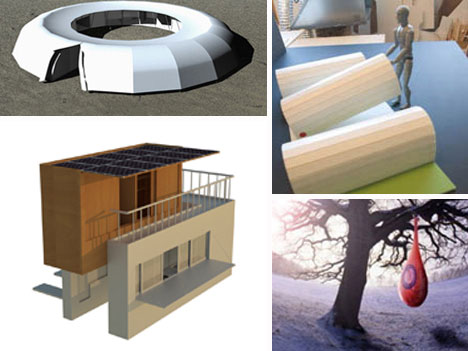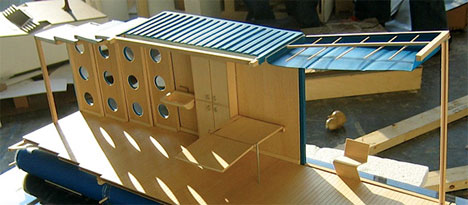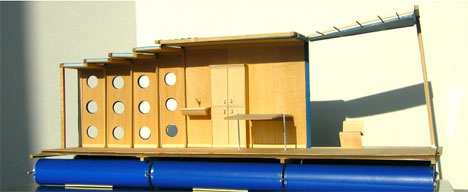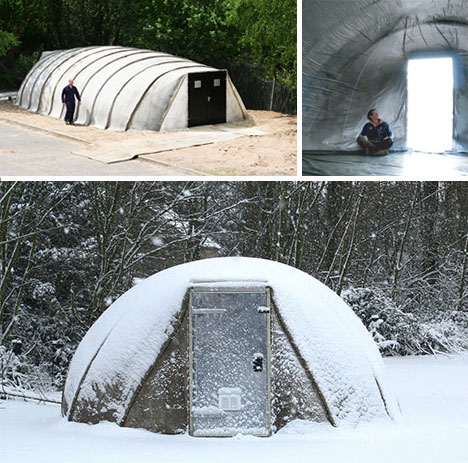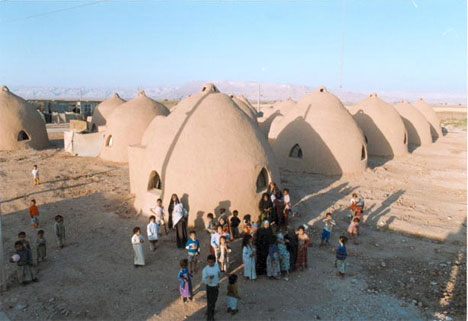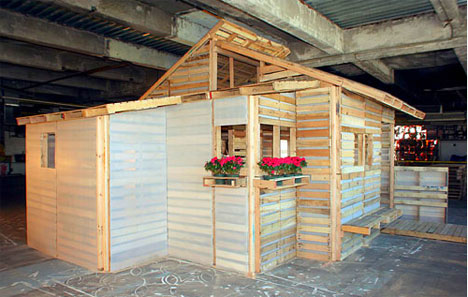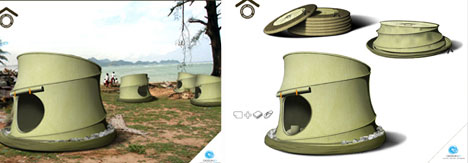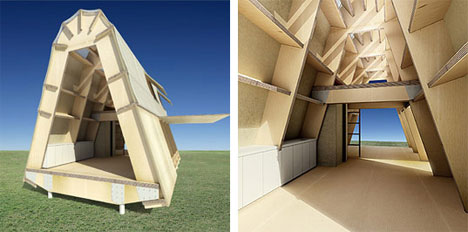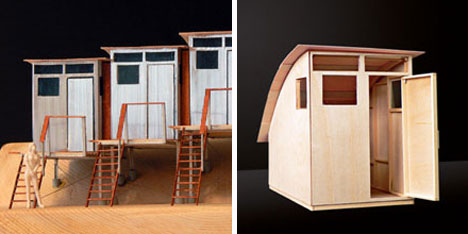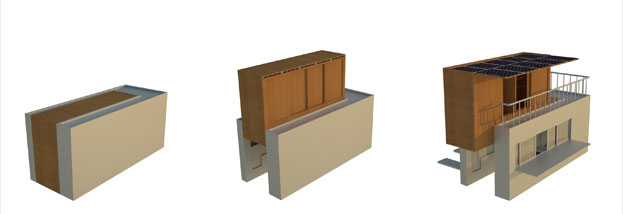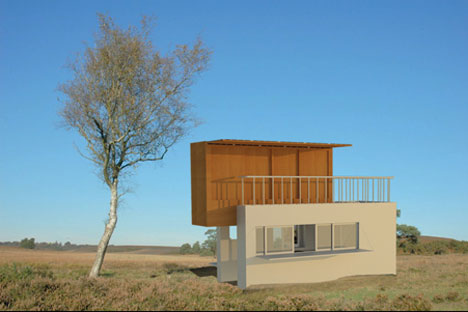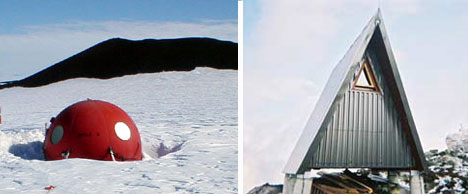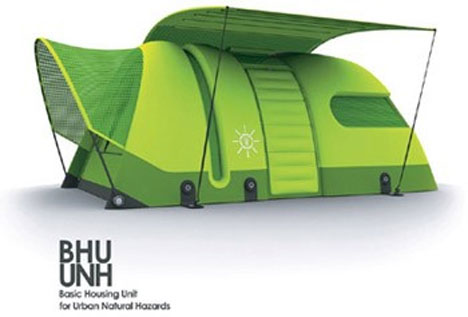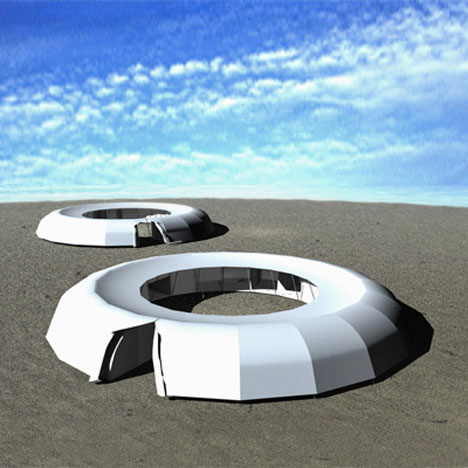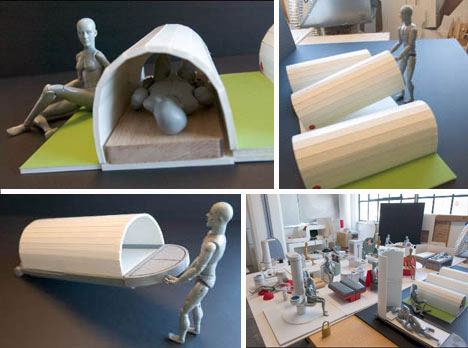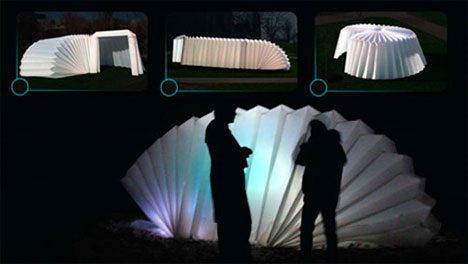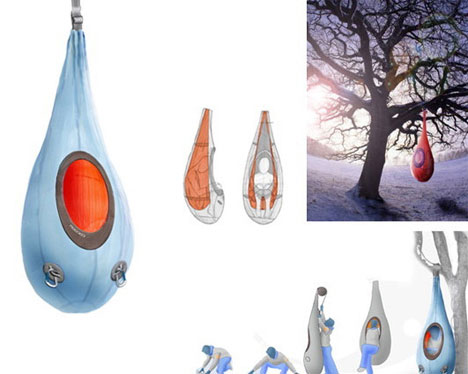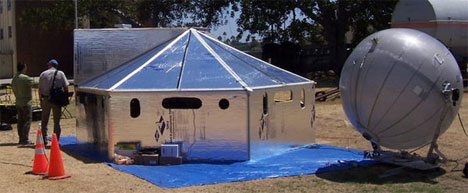A political or environmental crisis can be devastating to populations and families – forcing people from their homes and property. To lessen the human damage and provide a measure of safety and comfort for victims, temporary shelters are an invaluable asset. These designs, however, go above and beyond the standard stock emergency shelters in providing more efficient, affordable and all around more interesting living quarters.
(images via: Vestal Design)
SHRIMP (Sustainable Housing for Refugees via Mass Production) refugee housing units are compact, durable structures that can fold up to fit into 1/4 of a standard shipping container. When you do the math, that means that a single ship can carry housing for over 100,000 people. Each unit houses up to four people, is built of sustainable materials, and can be assembled on-site with only basic tools. And since the units can be set up on solid ground or float on six inflatable pontoons, they are extremely versatile for different types of situations.
(images via: Concrete Canvas)
With more than 35 million refugees worldwide, it’s become clear that housing solutions for displaced people need to be made a priority. Concrete Canvas shelters go a step beyond tents and other short-term shelters with a lifespan of approximately 10 years. They require nothing more than water and air to construct and can be built by crews with absolutely no training. Within hours of a crisis, the shelters can be set up and ready to live in.
(image via: CalEarth)
When Nader Khalili came up with “superadobe” structures in 1984, he intended them to be used in human colonies on the moon. Their practical application ended up being more Earthly in the end, though. Today, his groundbreaking design means that sandbags and barbed wire – two common materials of war – can be used to house those made homeless by war or other disasters.
(image via: GreenUpgrader)
Usually, time and resources are extremely limited after a disaster. Housing the affected population is a difficult prospect when there is no money and few supplies to construct temporary shelters. When Azin Valy and Suzan Wines of I-Beam Design considered this problem, the solution became evident: use shipping pallets. They are inexpensive, abundant, and sturdy, making them the ideal material to use for housing displaced populations. They can be left as-is for mild climates or finished off into a more permanent structure with the addition of solid wall coverings.
(images via: Design 21)
In the aftermath of a disaster such as a tsunami or earthquake, few things are more comforting than a warm, dry place to sleep. The Sanctuary shelter provides that comfort in a new and very appealing way. The biodegradable shelter pops open on its own with no need for tools or tent poles. Inside can be found a dry towel, biodegradable sandals, a first aid kit, and a warm blanket. The water-repellent material is insulated to keep residents safe, and the top of the shelter even features a reflective “X” to help rescue helicopters find those who need assistance.
(image via: Inhabitat)
For $35,000 you may expect a more permanent housing solution, but this recyclable cardboard house is an impressive temporary shelter. It goes up in less than 6 hours and comes with a composting toilet and water collection system. The pre-fab cardboard house started out as a concept but grew into an actual product. Sadly, it looks like the website to buy the cardboard houses is no longer operational, but you might be able to get the same effect for the same price with about 35,000 cardboard moving boxes.
(images via: Studio D)
Following a disaster, displaced people may find themselves crowded together in inadequate or makeshift shelters. Studio D‘s concept for temporary shelters would give each person their own living space and a place to keep their own possessions. The shelters use common materials and are simple to erect, making them an ideal choice for housing and protecting those made homeless due to any type of disaster.
(images via: Archimintak)
Finding and constructing housing for displaced people requires a dependable way to get the building materials to the site. These temporary emergency shelters come packed two to a shipping container and can be delivered via truck or cargo ship. The ingenious design includes a center piece that pops up via hydraulic pump, creating separate living and sleeping spaces. Photovoltaic cells and a rainwater collection system make these shelters the ideal way to deliver functional housing to any disaster site.
(images via: Exo and Club Tread)
When climbing a mountain or hiking in a remote region, it’s not unusual to see emergency shelters dotting the landscape. These shelters have helped plenty of people escape harm in case of avalanches or stay safe while awaiting rescue for some other type of emergency. The type of shelter depends on the landscape and the particular dangers of that area. The “apple” shelter on the left can be found in Castle Rock, Colorado. Golden Ears Emergency Station, on the right, is located in Golden Ears Provincial Park, British Columbia.
(image via: IEA-PVS)
When the Lisbon Ideas Challenge asked for innovative Photovoltaic (PV) applications, the Basic Housing Unit for Urban Natural Hazards was one of the most intriguing entries. The temporary housing unit incorporates a PV film and inflatable structure, making it an ideal way to house displaced urban victims of natural disasters.
(image via: Yanko Design)>/h6>
The “Sphere” design from Felix Stark provides for not only the basic physical needs of disaster victims, but the social needs of displaces people as well. The center of these tents can be used as a meeting place for residents, while individual units can be used to maintain privacy and personal space.
(images via: University of Michigan)
Inspired by the stackable plastic beds used in overcrowded prisons, University of Michigan professor Allen Samuels devised a clever way to house refugees. His temporary huts are made of biodegradable, easy-to-clean, lightweight plastic. The wheels on one end make it easy to move around, and there is even a bit of room to store personal belongings.
(images via: Inhabitat)
Time is of the essence when disaster strikes. Hours are precious, and if affected people can be housed right away the impact of a disaster can be greatly minimized. The reCover shelter is designed to be a first-response shelter for those forced from their homes due to disasters or evacuations. It can be used for up to a month and can house a family of four. The structure folds flat for storage and transportation, making it easy to transport a large number of them to where they’re needed.
(images via: Campist)
When you’re stuck out in the elements or simply get separated from a group, staying in place and waiting for help may be the best idea. The Cocoon Emergency Shelter from designer John Moriarty is intended to keep you warm and safe until help arrives. You simply hang it from a tree or any other off-the-ground location, then climb inside and let the insulated materials keep you warm.
(image via: Hexayurt)
For about $100, refugees can be sheltered in Hexayurts: sturdy and space-economical structures meant to temporarily house those in need. In less than two hours, a cardboard Hexayurt can be built and ready to move into. If you have a bit more time and money, Hexayurts can be built from nearly any building material available.
